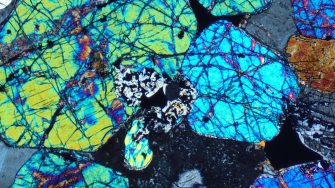ARC Linkage Natural Hydrogen Project
Hydrogen generation by subsurface iron mineral transformations.
Hydrogen generation by subsurface iron mineral transformations.

Natural hydrogen has the potential to become a significant contributor to the low carbon energy economy, with interest and exploration increasing globally.
Of the potential pathways that can generate hydrogen in the subsurface, the reduction of water by iron-containing minerals, such as during serpentinization, has been identified as the most prospective. However, there are still many fundamental factors to consider when determining the resource potential of different systems, including the underlying mechanisms that can lead to hydrogen generation from iron rich minerals.
A team based in the Water Research Centre at UNSW Sydney are working with colleagues from Geoscience Australia and geoscience agencies within the New South Wales, South Australian, Tasmanian and Western Australian state governments to assess iron-mediated pathways of natural hydrogen generation in Australian subsurface environments. Our primary goal is to develop open-access predictive tools to help assess the exploitability of natural hydrogen generating environments in Australia. Furthermore, we hope to apply this knowledge to investigate the potential for engineered retrieval of hydrogen from iron-rich subsurface environments.
In this project, the key mineral transformations associated with hydrogen production are being investigated with the goal of providing mechanistic insight into the geochemical processes underpinning both the changes in mineralogy and the hydrogen production of this resource. These mechanistic insights are likely to be critical to answering the question “can we viably recover this resource and, if so, at what rate and for how long”.
A series of laboratory-based studies based on hydrogen production will be undertaken using specific natural mineral assemblages from selected core materials. Particular attention will be given to assessing the rate and extent of hydrogen generation of iron minerology with the presence of potential mineral catalysts, such as nickel, which has been recognised to accelerate hydrogen generation in synthetic mineral assemblages. This will be combined with studies of the effects of temperature, pressure and fluid pH to provide a comprehensive understanding of the most important sub surface environmental conditions that are required to achieve significant hydrogen production.
Mineral and elemental characterisation of sampled core sections will be undertaken at the UNSW Kensington campus and at our partner organisations using a range of techniques including:


Examples of 3D micro-CT, 3D phases image and 3D single mineral phase images including aluminium, iron, and nickel.
Professor T. David Waite (Project Lead) - Professor Waite is an internationally recognised researcher in iron geochemistry and environmental technology with particular expertise in redox processes involving iron.
Professor Ryan T. Armstrong – Professor Armstrong is an expert on ‘Digital Materials’ characterisation related to subsurface process that involved flow and transport. He will oversee the X-ray computed microtomography (μCT) characterisation of core samples, fusion of data from different image modalities, and in situ experimental studies.
Dr Andrew Feitz (Geoscience Australia) – Dr Feitz is the Director of Low Carbon Geoscience and Advice at the Australian Government’s national geoscience agency, Geoscience Australia.
Dr Christopher Miller - Dr Miller has extensive experience in the investigation of reactions involved in the transformation of iron minerals in aqueous environment
Higher Degree Research Students
Emma Black
Jiejie Li
State Government Partner Investigators
Dr Peter Haines – Geological Survey of Western Australia
Ms Elinor Alexander – SA Department of Energy and Mining
Dr Kevin Ruming – Department of Regional NSW
Mr Ralph Bottrill – Mineral Resources Tasmania